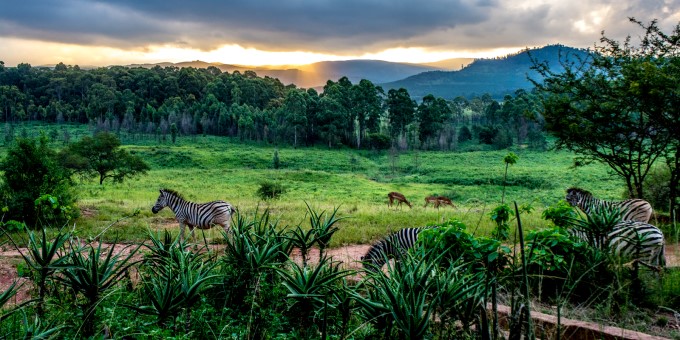
Confessions of a Technophobe, New Series 5
Having climbed the highest mountain – in South Africa that is – and swum in three oceans, I now turn to my third choice, wildlife.
I had a bizarre introduction to African wildlife at age ten, I have to re-tell this story because it sets the scene for all future encounters with the great beasts that roam Africa’s plains and forests. My parents and I were staying with my grandfather in a Nairobi hotel. We were keen to get into the bush and see some animals. My grandfather finally told us that the following day we would do an expedition into the wilds. That morning we loaded up a couple of trucks containing African trackers (as we thought), picnic hampers and champagne, etc. – all necessary prerequisites for an English Gentleman’s foray into the untamed wilds of Africa.
My grandfather arrived with an unexpected guest, an Egyptian prince, cousin of King Farouk, and a current girlfriend. We set off and a couple of hours later my grandfather stopped the vehicles. We got out and looked around. It was a sparse area littered with thorn bushes and tufts of grass. In the distance we could see a herd of dainty Impala, with a couple of stately giraffe nibbling at the fresh foliage at the top of the bushes. Behind them again were three or four elephants. It was in fact a glorious microcosm of life in untamed Africa.
My grandfather spoke to the trackers and instead of herding the animals towards us for a better look at them, to our consternation they chased them all away. We looked askance at my grandfather, an eccentric old man with a quirky sense of humor. Was this perhaps some obscure lesson in being patient or not always getting what one wanted, namely a good look at the animals?
With a broad smile my grandfather and the prince disappeared back into one of the trucks, only to re-appear moments later with a number of butterfly nets. They handed a net to my parents and I, keeping one each for the two of them. The awful truth suddenly dawned: we were part of a butterfly hunt and to hell with elephants, giraffe and so on.
So for some hours the family Dresser followed its patriarch around, chasing butterflies. It turned out that my grandfather and the prince were the leading butterfly collectors in Africa, and we were considered to be suitably honored to be allowed to chase these admittedly beautiful little creatures as they fluttered by.
Returning to the city, the prince instructed his girlfriend to take me to a nearby store, where she was to buy me a present. The young woman was English with a pronounced cockney accent. She was very pretty except for the scowl on her face as she reluctantly dragged me around the store that revealed very few suitable toys for me. Noticing her increasing impatience, I quickly picked up two Ping-Pong (table tennis) bats and a net and told her that this was the perfect present for me. The fact that I had no table to play the game on did not worry me at the time. All I wanted to do was to get out of there, in case the young woman strangled me.
Some weeks later my grandfather drove us from Nairobi to Mombasa, a coastal port from where we were scheduled to catch a Union Castle liner to Durban in South Africa. On the way, we saw a rhino grazing close to the road and my grandfather, with no butterflies in sight, obliging drove close to the great beast – too close as it turned out. The rhino angrily turned away from the clump of grass he was grazing on and charged the car. My grandfather, as an ex-racing driver was quickly in reverse, skidded around on the gravel and shot off at speed down the road. The rhino quickly gave up the chase – but for my dad and I, it was our first real hint of what Africa could be like.
We also stopped for a picnic on the banks of the Tsavo River. While my mother and grandfather were laying out the goodies, my dad and I strolled across to the banks of the river and stared into its muddy waters. Perhaps my dad was wondering what kind of fish could be caught. He was a keen trout fisherman but not averse to catching other species if no trout were available. Suddenly a huge crocodile leapt out of the river with its jaws agape, missing both of us by inches. We retreated hastily and later learned that had it caught either of us, we would have been dragged into the river and drowned. Our body would then be stored in a hole in the riverbank until it was thoroughly rotten and then eaten by the croc.
From chasing butterflies to two near misses from two truly dangerous animals, we were finally made aware of the unforgiving nature of life in Africa. The first article I wrote as an adult describes the continent as “The land of sudden death.” Despite this, it’s a truly stimulating and exciting part of the world, where its incredibly beautiful and varying scenery, plus the innate niceness of the African people – unless they happen to be politicians – makes this vast and largely untamed land a place never to be forgotten!
We settled into a life in Cape Town, South Africa, truly one of the most beautiful cities in the world. The emphasis on outdoor activities was primarily beaches and mountains. However, when climbing Table Mountain which I did every school holiday, I was wary of the packs of baboons on the mountainside. Some people, to their detriment, try throwing rocks at them to keep them away – not realizing that the baboons can throw rocks back harder and with more accuracy than us puny humans.
Apart from the occasional leopard in the surrounding mountains, very few wild animals are left in the Western Cape, except in a number of game parks nestling between the winelands (which produce some of the world’s best wines) and the spectacular mountains ranges. Tourism in the Cape is a major industry and the combination of sipping a superb wine whilst watching some of the big five (elephants, lions, rhinos, giraffe and cape buffalo) drinking at a waterhole as the sun disappears over the mountains is a rare experience indeed.
`After leaving school, I travelled to Namibia to join my parents in Walvis Bay, a seaport and base for the then-large pilchard fishing industry. My dad had curiously bought a fishing trawler despite no knowledge of trawler fishing and even signed on as crew for two years while he learned the business of catching the high-protein pelagic fish, the pilchards. These small but tasty creatures, somewhat larger than a sardine, have an unusual history. The American novelist John Steinbeck wrote about them in his famous novel Cannery Row. Because of over-fishing, the pilchards got fed up and left the shores of California. After disappearing for two or three years, they unexpectedly one day reappeared in the plankton-rich waters off Walvis Bay.
It didn’t take long for enterprising fishermen and businessmen to combine to create the largest pilchard industry in the world in the 1950s with five large factories processing and canning the fish as soon as they were scooped from the sea and delivered to the port. Around Christmas there was a two-month break from fishing. The fisherman who had earned a lot of money took taxis for the 2000-mile trip to Cape Town, drank themselves stupid and chased girls until the money ran out. They would then crawl back to Walvis Bay and wait for the fishing to start again.
My dad along with some other boat owners started shark fishing in the off-season for pilchards. In the heat of the day, they would jump overboard and have a swim with a crew member standing guard with a rifle in case a shark wanted some revenge for the disappearance of his cousins.
There was very little wildlife around Walvis Bay. Further up the Skeleton Coast (so called because of the number of ships, both sailing and steam, that were wrecked off the coast with treacherous sand banks, rocks and powerful currents), a surprising number of black-mane lions and large elephants survived in the desert. The elephants developed splayed feet with which to negotiate the soft sand. Occasional oases can be found in the desert where waterholes with some vegetation are available.
In later years when I was focused on making documentary films, wildlife was not my major subject matter. Nonetheless I still did quite a lot of game filming. For my tourist documentary “South Africa the Best Kept Secret,” we spent six weeks in the Kruger National Park and were given special permission to travel on the firebreak trails which gave us access to game not seen or disrupted by the hordes of tourists that visit the Kruger Park every year. Even so, finding the animals was not easy – our six weeks in Kruger ended up with no more than two minutes of screen time – but we did get some fine shots.
I particularly liked a sequence, set to music, where an elephant leaned his backside against a tree in order to scratch an itch. There were hordes of monkeys leaping around in the trees. We found a large herd of cape buffalo, considered to be among the most dangerous animals because of their inherently bad temper. Unfortunately for us they were peacefully grazing like any old herd of cattle. Desperate for some action, I finally climbed out of our camera truck and ran at them. They looked at me in astonishment, then as their anger mounted, they started towards me. I immediately reversed and sprinted back to the truck. At least we got some decent footage of the herd on the move.
I eventually came to the conclusion that the smaller game reserves were better suited for game viewing and filming. The animals were restricted and were more visible. Mlilwane Game Reserve in the neighboring kingdom of Swaziland is one of my favorite parks. It is hilly and far more beautiful than the flat terrain of the Kruger Park. It is situated in Ezulwini (the valley of heavens), surrounded by mountains. Filming there I got five giraffe to run by chasing after them. They have a marvelous stately gait and are one of my favorite animals. While interviewing an African game guard one day, we spoke about the danger of rhinos and their short temper. As we spoke, two rhinos came up behind us but were grazing peacefully. When they got too close in the estimation of the guard, he turned around and said “Shoo.” The huge creatures retreated swiftly and any dialogue between the guard and myself about the dangers of the beasts was ruined!
Terence Reilly inherited the Mlilwane farm from his father. He turned it into a reserve, earning the fury of local farmers, who had no interest in preserving wildlife and saw them as entirely destructive. Fortunately, the late King Sobhuza (the longest-reigning monarch in the world until Queen Elizabeth superseded him) loved wildlife. He had a massive property in the Lowveld area of Swaziland and gave Terrence “Ted” full permission to relocate animals from his land to Mlilwane. He also told the farmers to shut up and support a game reserve in Swaziland. Such was the respect of his subjects for the old king that they promptly obeyed him. Ted had no more trouble from his neighbors.
In some ways Ted was a lunatic. He would use his anesthetic dart gun while driving at full speed in his battered old jeep over the veld, raise the gun with one hand and dart an animal. As the dart took effect he would drive close to the animal and literally leap from the jeep onto the animal’s back and wrestle it to the ground. This was to minimize the creature’s efforts to remain standing. The jeep would wander on driverless and eventually stop. He did this one day without warning while we were filming with him in the jeep. Amazingly, as he did so, one of the jeep’s wheels broke off and we were lucky not to overturn as it skidded to a halt.
Some reserves specialize in preserving an endangered species such as the cheetah. These beautiful creatures, along with the leopard, have been extensively shot out by farmers who regard them as vermin. The fact that they are among the most beautiful creatures on earth cuts no ice with them. Legislation forbidding the killing of the cheetah and leopard has had little effect but there were at least two cheetah parks successfully breeding these animals. I spent some time at the Loskop Dam Cheetah Reserve when it was exclusively breeding cheetahs. Today it has expanded into a more general park on the banks of the huge Loskop Dam. When I was there many years ago, the owner Desmond Varaday (a Hungarian by birth, whose son worked with me in the movie industry) allowed me to actually play with the cheetahs. I found them to be very nervous but once they got used to me, they were quite affectionate and liked to be stroked.

In 1968 in Cape Town, a distant cousin of mine, Anthea Westphal, founded SANCCOB, an organization dedicated to the saving of penguins and other sea birds that had been caught in oil spills from ships rounding the Cape of Good Hope. Some of the ships carrying oil, such as the Treasure, actually sank off the Cape coast causing a massive oil spill in the ocean. Many hapless penguins were covered in oil and would have drowned but for the efforts of Anthea and her team who rescued the birds and cleaned them with detergent. It was tricky work. The cleaners were frequently bitten by the penguins who had little appreciation of the fact that their lives were being saved. A penguin has a particularly sharp bite; it took a brave person to try and control the oil-soaked and terrified birds. Nevertheless, they did a magnificent job and over the years saved the lives of hundreds if not thousands of the birds.
The relationship between wildlife and humans has always been a difficult one. Many species have become either endangered or, like the Quagga (a horse-like animal with partial zebra stripes) actually extinct. There are many conservation groups around the world doing their best to preserve wildlife from the ever-encroaching ravages of modern “civilization.”
As with conservation, ExoTech is dedicated to saving computing from painting itself into a corner. Current computers have reached the point of being incapable of developing much further. Fortunately, ExoBrain eliminates a basic flaw in existing computing systems and represents a paradigm shift into a new realm of capability for computing, an essential part of our lives today.

